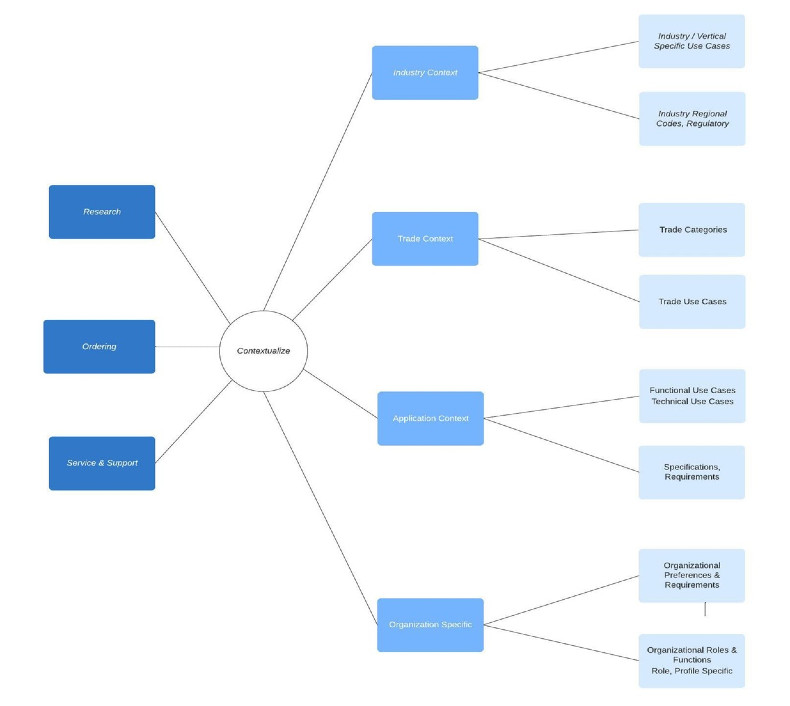B2B buyers are on the hook for making accurate and timely purchases for their business. Purchasing the wrong product, a lack of product or quantity, and extended lead times are common concerns. B2B sellers are looking for fast fixes to those concerns and often look to user experience (UX) modernization as a solution. But that can result in a "lipstick on a pig" scenario that fails to consider the specific customer purchasing processes and product use cases.
Organizations need to clearly identify and solve for the pain that their buyers feel, both in their experience and across their industry in general. Chances are it is not the UX but the underlying functionality that is the biggest complaint.
The B2B E-Commerce Channel
Technology today allows you to convert your e-commerce channel into an active purchasing partner for your customers that simulates an in-person account manager who knows not only the customer but also the product and industry knowledge of how the product is used.
Such a digital channel can shoulder most of the purchasing burden while providing an easy one-stop shop for product and application information, purchasing, service, and support.
However, there is a lot of interference in B2B commerce today. The current state of anomalous supply chain challenges, SEO spamming (and overall spamming, for that matter), and exponential growth of purchasing options puts your prospects and customers in a position where they could go elsewhere. On top of that, we are fighting with shrinking attention spans.
Let's explore fundamental ways to step up your B2B e-commerce game.
Four Ways to Improve the B2B Buying Experience
1. Use interactive buyer journeys
At your buyers' first touchpoint, it's important to recognize and react to where they are in their journey. That gives you an opportunity to captivate buyers and encourage them to continue on their journey.
For example, if they are coming to your touchpoint in their research stage, then it's key to provide information and content versus pushing a product that they're not ready to buy yet. If they land on a topic page, category, or product page from a campaign or search engine, they are giving a powerful signal, so the platform should align the experience accordingly to that topic, category, or product.
Although dynamic content and personalization have been the traditional mainstay, moving to a more interactive and conversational experience in which everything across touchpoints aligns to the buyer's journey and ultimately shops for them will be the most effective. Conversational applications such as chatbots that are commonly used in service can be a stepping stone to that sort of interaction.
2. Eliminate irrelevant and noisy experiences
Irrelevant and noisy experiences can be confronted with a battery of technologies. Ways to eliminate noise include increasing relevancy, contextualization, and personalization.
If we look at them as layers...
- Improved relevancy is the top layer that includes better understanding and alignment of your buyer and their language, giving more accurate results.
- Contextualization goes further by ranking results aligned to the buyer's context such as region, industry, and application.
- Finally, personalization takes into account the buyer and organizational historical transactions, interactions, and preferences, and it predicts intent through current behaviors to add further precision to the results.
B2B sites perform best when they offer an experience that aligns with the underlying customer dimensions. such as industry, trade, role, application, and organization. Experiences that are in harmony with the nuances of those dimensions eliminate the guesswork, effort, and purchase stress on the customer, therefore increasing customer value. Modules of the experience such as search, browse, content, and recommendations should also be contextualized to drive purchasing ease and accuracy.
A good place to start would be resequencing facets or showing products ranked by their applicability to a specific trade. The following diagram depicts a common context tree in B2B.
Implementing contextual dimensions can include the following:
- Domain-specific knowledge graphs are already used by B2B heavyweights such as Alibaba, and they can be applied in many ways to drive relevancy and simplify experiences, including natural language processing and buyer goal detection. Language used by customers for products and applications is often different from what is actually in the system.
Such technology is particularly advantageous when buyers are looking for products and information by application, by project, or when using identifiers for products that are different from what is in the system.
Incorporate industry or trade-specific knowledge graphs and dictionaries to ensure that language and colloquial nuances such as slang are already recognized by the system. That can be augmented on an ongoing basis through mappings such as alternative labels, part identifiers, and names. - Machine-learning can be applied to nearly every aspect of the B2B buying experience. Going beyond traditional approaches such as recommendations and personalization, machine-learning can be used to improve conversational applications, including learning how to prompt and guide buyers, detecting and pivoting buyer journeys, and learning applications or use cases.
That can be used to automatically tune the relevancy of results for the particular context and simplify the buyer's purchase process. - Dense vectors can be incorporated into search, browse, and recommendations to uncover and represent content and products based on relationships and topical distance, such as semantic relationships to a keyword, phrase, category, or product. Dense vectors go way beyond traditional matching algorithms, which are limited to strict matching of what is in your product data.
All three of the aforementioned technologies are used by leading consumer applications such as Google and Amazon—companies that set buyers' expectations. Any experience that is not taking advantage of those technologies puts your business at risk of losing out to your competitors.
3. Eliminate the guesswork for buyers
Uncertainty is a major factor in purchase hesitancy and abandonment. Highly attributed and fresh product data, real-time availability, and sufficient product information to support research and selection are factors that drive purchase certainty.
Buyers are expecting greater information and transparency around products, from sourcing to fulfillment. Exposing those data points throughout your purchase process will reduce hesitancy in the buyer experience.
Buyers should be able to find information on the website without picking up the phone. And for buyers who still prefer transacting over the phone, customer service teams should have at least the same degree of usability and information the buyer does.
4. Use proactive processes
The time has never been better to employ proactive processes. The combination of supply chain issues and inflation are driving buyers to plan way ahead and, in some circumstances, hedge. Employing technologies that facilitate those trends will dramatically improve results and buyer satisfaction.
Intelligent push-based notifications are one example of a tool to minimize customer frustration. They can be proactive (e.g. low in stock), reactive (e.g. back in stock), or even passive, such as notifications communicating the status of an order or price drop. Shop bots that automatically search and source products on behalf of the buyer are also gaining in popularity, as they can automate numerous aspects of purchasing.
Upgrading Your Total Experience
As waves of new innovative technologies continue, it is critical to incorporate them into your buyer experiences. If you're on an older, monolithic B2B platform, you can still derive a lot of business value from switching out elements of functionality without completely replatforming.
When weighing technology investments, consider the entire ecosystem of your customers, employees, and support agents, as well as the touchpoints they interact with. Connecting them can provide a wealth of intelligence that benefits both customer- and employee facing- channels.
Invest in a platform that can learn and apply an approach that is ideal for each circumstance.
More Resources on B2B Buyer Experiences
Five Keys to Building Better Buyer Experiences
How to Attract Buyers in the Modern Business-to-Business Market
Three Trends in B2B Buyer Behavior and How to Generate Quality Leads by Addressing Them





